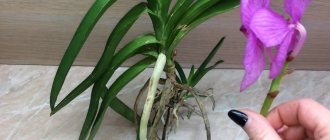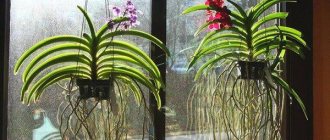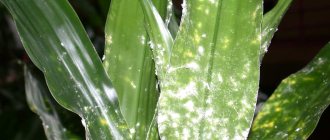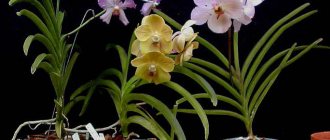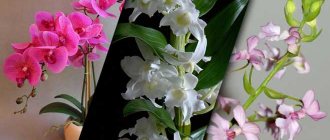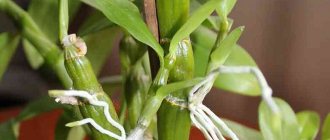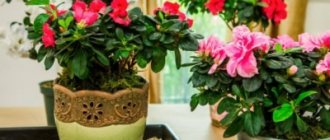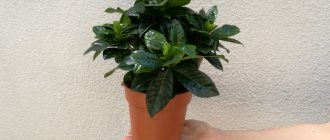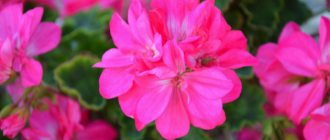This variety of orchid goes back to the 18th century in Asian countries. That's where she comes from.
In addition to its beautiful flowers, this orchid is unique for its root system : unlike other varieties, its roots are more powerful, they can receive moisture even from the atmosphere. Therefore, the Vanda orchid is not threatened by prolonged droughts and possible burns. However, this variety is quite whimsical and will require great care during care . One slight mistake and the plant may die. Next we will tell you how to care for the beautiful Wanda.
Popular species to care for at home
Wanda Rothschild
The most popular among flower growers are five varieties of the Vanda orchid:
- Blue. It grows up to 1 m high. It has a well-developed root system. The diameter of lavender flowers reaches up to 10 cm.
- Tricolor. Reaches a height of up to 2 m. The color of the flowers is white or cream with spotting.
- Sandera. The leaves grow up to 40 cm in length. The flowers have soft pink petals with a white border.
- Rothschild. The hybrid flower was the result of crossing the blue Vanda and Sandera. The color of the flowers is from blue to dark blue.
- Rolled. In nature it reaches a height of up to 3 meters. It has long (up to 20 cm) and narrow (3 cm) leaves.
For more information about all types of this orchid, see here.
Distinctive features of the flower
Indoor Wanda has the following characteristics:
- Aerial roots reach one meter in length. Roots can absorb moisture not only from the soil, but even from the atmosphere.
- The stem is cylindrical and can grow a meter in height. Densely covered with leaves arranged in one plane.
- The leaf blades are green, sometimes with a gray tint. Their length depends on the subspecies. There are specimens with foliage 25–40 cm, and there are also those in which it grows up to 100 cm. One leaf grows within 1.5 months (with proper development).
- Flowers are collected in raceme-shaped inflorescences. The main feature of Vanda is the ability of flowers to grow with increasing brightness of color even after the buds have fully bloomed. Such flowers are often grown for cutting; they can stand in water for up to half a month.
- Another feature of Wanda is the absence of a rest period. It can bloom at any time of the year. But during the period of bud blooming, the growth of leaf plates slows down. One plant lives up to 30 years.
Choice at time of purchase
Every novice gardener wants to buy a Vandu orchid for their collection. However, more experienced ones advise not to buy it if there is no practice in growing other types of orchids.
If you decide to buy Wanda, then contact a specialized store. When purchasing, check:
- Leaves. Must have a uniform green color, without blackening, pinpoint spots, mechanical damage or signs of wilting. They feel elastic and smooth to the touch.
- Roots. Excessively dry or soft ones indicate improper care and the beginning of decay. The color of the roots is uniform, without any spots.
- General condition of the plant. There should be no obvious signs of the presence of pests or diseases. The optimal age of a flower to buy is more than two years.
IMPORTANT: It is recommended to purchase a flower that was grown in local climatic conditions. Imported from other countries do not acclimatize well.
General information
The Vanda orchid is a monopodial epiphytic plant, the distinctive feature of which is its aerial roots. They are thick and powerful, covered with a layer of velamen, which allows them to absorb moisture from the environment. Painted in grey, silver and gray tones.
Under natural conditions, the root system can reach 2 m in length.
Distributed in continental Southeast Asia, Indonesia, and northern Australia.
The genus name comes from the Sanskrit word "vanda". This is what the people of India call these plants.
first described by botanist William Johnson in 1795.
When purchasing orchids of this group , you need to take into account that the name “Vanda” is not 100% accurate and hides a very large group of various hybrids, which in fact in 80% of cases are not pure Vanda.
Vanda John Smith x Vanda Lacaille
When buying an orchid in a regular flower shop, you are most likely buying a Dutch hybrid plant from Anco Orchideen, which buys seedlings en masse in Asia, germinates them until the first flowering in its greenhouses and sells them sorted by color: Vanda Blue Magic (blue orchids), Vanda Orange Magic (orange), etc. These names are not real you should not rely on them when searching for conditions of detention .
Biological features
In their natural environment , Vandas settle in trees rather than rooting in the soil.
Wanda has no pseudobulbs Numerous green leaves are located on a long cylindrical stem. Depending on the place of origin, they are belt-shaped, elliptical or rolled into a tube.
Erect or hanging flower stalks appear several times a year. For 2-3 months they hold multi-flowered racemes - inflorescences.
Vanda Dark Kulwadee
Peduncles appear from the axils between the leaves and bear from 2 to 15 flowers. As a rule, from 1 to 4 peduncles can bloom at the same time.
The flowers are round and large. They come in single-color, two-color, variegated and decorated with patterns of dots and lines. The variety of colors is amazing to the core. Some species have a pleasant aroma.
V. Gordon Dillon
It is noteworthy that immediately after the buds open , the sepals and petals are painted in pale colors and are small in size . But after 2-3 days they acquire a more saturated color and increase in size.
Growing in a pot, glass and without soil
Under natural conditions, the Vanda orchid grows in a suspended state without soil.
Therefore, it is not necessary to use a substrate for growing at home. If this confuses the gardener, then you can purchase a regular substrate intended for orchids in the store. It is poured into a wide bowl and placed in a flowerpot with many holes on the sides and bottom; they provide ventilation to the roots. For growing Vanda, ordinary pots are not used. Nets, wire pots, wicker baskets, and glass flasks are suitable for it.
Orchid roots are so sensitive to excess moisture that they can quickly rot in any substrate.
If Vanda is placed in a glass vase without a substrate so that its roots are inside and the ground part is outside, then it will feel good and grow. This way the flower receives enough light. It is recommended to use a container with a wide bottom and a narrow top. A vase in the shape of a glass, cylinder, or ball looks good.
Growing Vanda in a wicker basket is the most common method among gardeners. This way the root system does not rot from excessive moisture and receives enough light and air.
How to transplant Vanda?
Orchid variety Vanda: photo
Before making a direct transplant, you need to make sure that the roots of the plant do not rot and are not damaged. If there are still rotting parts, they must be removed as soon as possible. The main thing is to do this while the Vanda orchid species is in a dry state. It is necessary to systematically replant young plants, because they are constantly growing, but those whose roots are already too long will take quite a long time to adapt to life in new conditions, so you need to keep an eye on them.
An urgent transplant of the Vanda orchid is required if anything from this list occurs:
1) The substrate is too compacted. Over time, they all become denser after a sufficiently large number of waterings. This risks causing the soil to stop allowing air to pass through and the plant to wither.
2) The substrate was initially of rather low quality. This can be seen by how well it allows moisture to pass through. If the substrate does its job well and dries quickly enough, then no replanting is necessary. Otherwise, it, like the preparation of a more suitable substrate, is simply necessary.
3) Soil contamination. This also happens over time, no matter how good your substrate is. However, pollution can still be slowed down if you handle the plant very carefully.
4) The root system goes too deep into the soil. This also risks the fact that the plant will not receive enough moisture and nutrients, which we, of course, do not want.
5) The appearance of rot on the roots. There are a huge number of reasons for its appearance, but we will not focus our attention on them now. The main thing is that when you see rotting, whatever its cause, you need to urgently remove the affected areas of the rhizome and replant.
Orchid variety Vanda: photo
How to water in a basket and glass vase?
Watering the Vanda orchid has its own characteristics depending on the container in which it is planted.
Growing in a wicker basket obliges the owners to irrigate the roots often: in the summer - every day, in the winter - once every three days. If the flower grows in a plastic pot with holes and substrate, then watering is carried out only when the soil is completely dry.
Growing in a glass flask:
- Pour water down the side of the vessel until air bubbles stop rising. This indicates that the flower has absorbed as much water as possible into the roots.
- Excess water is carefully drained after 15–20 minutes.
- Watering is carried out twice a week.
In the video you can see how to care for the Vanda orchid at home. It describes in detail how to water and maintain in a glass vase:
Vanda Orchid: description of the variety
The Vanda orchid is rightfully considered not only one of the most beautiful types of orchids, but also, in fact, their queen. It is not surprising that its name has ancient Sanskrit roots, because in all centuries this flower has been highly revered. Moreover, this plant is called this way almost all over the world: from the two Americas to India. All this explains why this variety is so valuable and revered not only among gardeners, but also among those who simply want to decorate their home. By the way, not only the enormous popularity of this species, but also its amazing ability to crossbreed has allowed it to contain a huge number of hybrid varieties with amazing and outstanding qualities.
Wanda also has some pretty interesting growth characteristics in her own right. It belongs to epiphytic plants, which means that it has aerial roots and does not grow in the ground. Instead, Wanda prefers mountains and trees as her habitat.
Monopodial plants are another species of the Vanda orchid. What does this word mean? It means that plants belonging to this genus are capable of growing exclusively upward, without deviating to any side. Plants belonging to this genus often reach up to several meters in height. The monopodial genus includes no less than twenty-five different flowers and shrubs, and Vanda is one of them.
The stem, as already mentioned, of the Vanda orchid is oblong. Its entire surface is completely covered with foliage, shaped like oblong cylinders. Peduncles, from which flowers of incredible beauty will appear in the future, are located in the leaf axils. Each flower can reach eight to ten centimeters in diameter, and the shades in which they are often painted vary greatly. However, most often you will see pink, purple and blue Vanda orchids. Most varieties of this species have small veins that stand out on the surface of the petals. They are painted in a slightly darker shade than the petal itself, and in shape they form a kind of network or cobweb.
The natural habitat of the Vanda orchid is Asia. The countries where it is most common are Thailand, India and China. However, your home, wherever you live, may well become an excellent home for the Vanda orchid. Below is how to provide her with favorable living conditions.
Vanda Orchid: photo
Reproduction
Wanda rarely has side shoots. Therefore, flower propagation is carried out by cuttings and children.
How to propagate:
- Cut off the top of the flower along with the aerial roots. Place the resulting cuttings in a growth stimulator solution. Then transplant it into a new glass container.
- After cutting off the top, new lateral shoots grow on the trunk - “babies”. When the sprouts reach at least 5 cm and their own roots appear, they can be separated from the mother flower.
- The baby is placed in a pot with a substrate and greenhouse conditions with high humidity (at least 80–85%) are created.
Maintenance errors - table
| Error | Cause | Elimination |
| The leaves become dark green in color | Lack of light. | Move the plant to a more illuminated place or add additional light by turning on a fluorescent lamp. |
| The leaves are turning yellow |
|
|
| Leaves are soft and slightly wrinkled | Overwatering. | Follow the watering schedule. |
| Transparent spots on leaves | Sunburn. | If Wanda is in direct sun, she should be hidden behind a curtain. |
Transfer
Frequent replanting of the flower is not required, since it is grown hanging in a basket or vase.
Replanting is carried out only if the root container has become small, for example after purchasing it in a store or when the substrate needs to be replaced.
How to transplant:
- moisten the root system so that the substrate comes off easily;
- inspect hanging roots and remove dry, damaged or soft ones;
- Roll the long roots into a ring and place in a new pot.
Conditions of detention
Illumination
Many modern hybrids found on the market are already adapted to the sun of our latitudes and can be easily grown on the windowsill of an ordinary city apartment.
The duration of daylight hours is at least 12 hours . If there is not enough light, the orchid will not bloom.
Spring, summer: Bright lighting is required, but the sun's rays must be avoided, as their effects cause burns on the leaves. It is best to place it on western and eastern windows. The north window is not suitable.
Autumn, winter: For the winter, you can place the plant on a south window. If Wanda remains on the east window, she will need additional lighting.
V. Robert Delight Black
Carefully observe the orchid leaves - if they are green, shiny, elastic, then everything is in order with the lighting. If the leaves become darker and stretch out, there is not enough light. On the contrary, the fading of the foliage and the appearance of yellowish-brown spots on it indicate an excess of sunlight, even burns.
Temperature
Each hybrid (which can be bought in a regular store) has a different set of genes from its natural parents, therefore, with regard to the temperature regime, they all have individual characteristics , some grow better in warmth, while others do the opposite.
Vanda Sansai Blue
In order to determine the temperature regime of an orchid, you need to find out in what temperature range it grows the largest number of new cells (roots, leaves, peduncles, etc.).
Recommended temperature:
Day : 22-28 °C; Night : not lower than + 14 °C.
Diseases and pests
The flower is susceptible to various diseases if the rules of care and maintenance are violated. Diseases such as fusarium, fungus, bacterial rot, and viruses occur.
Pests attacking the orchid:
- thrips;
- spider mite;
- scale insect
History of the appearance of the flower, natural habitat
In its natural environment, the royal Vanda orchid is found in Australia (mainly in the northern regions), India, China, Indonesia, Thailand, and the Philippine Islands. The flower was first seen in southwest Asia. Its description was presented by the scientist William Jones, who specialized in studying the characteristics of these regions (their culture, flora). The flower was registered under the name "Vanda" in 1795, he received it due to its beauty, sophistication, and tenderness. Translated from Sanskrit it means “whisper of the wind.” Many believed that the scientist named the flower in honor of the Polish Princess Wanda.
In its natural environment, the orchid reaches 1.5 m in height. It belongs to the epiphytes. This means dependence on other plants. Indeed, the flower develops on the bark of trees. This feature allows the orchid to receive moisture from the air, leaves of neighboring plants and at the same time reach for the light, leaning on the trunk. But among the varieties of orchids there are exceptions: terrestrial species, lithophytes.
Note: For growing indoors, you can purchase hybrid varieties of the Vanda orchid - these are the ones that go on sale. They are also colorful, just like natural plants. The advantage of hybrids is larger flowers in most varieties (up to 15 cm).
Possible problems
The occurrence of various problems when growing Vanda orchids at home is a common occurrence. This is explained by the capriciousness and complexity of maintaining the flower. What to do, if:
- The leaves wither and turn yellow. Reason: the flower is under stress. It can occur if there is a constant draft in the room, an open window, high or low air temperature, lack of fresh air, or lack of nutrients. If the leaves turn yellow and dry, then the plant is being attacked by a mealybug. Eliminate the cause.
- The buds are falling. Reasons: lack of lighting or watering, low air humidity, sudden temperature changes, excess or lack of fertilizers, natural aging. Eliminate the causes.
- The peduncle withers and dies. Reason: dry air in the room or soil in the pot, parasite damage. Remove the flower stalk, increase humidity, start pest control.
What other diseases of orchid leaves are there and how to treat them, read here.
Reanimation of roots if they are dry: how to grow them?
The roots begin to dry out if the air in the room where the orchid is kept is too dry. To eliminate it, it is necessary to water by completely immersing the root system in water and spraying the roots more often.
If this method does not help, and the plant is left without roots, then it is necessary to grow new ones. To do this you need:
- Trim off diseased areas of the roots and secure the remaining stems with wire.
- Hang the flower in the shade with the top down.
- Regularly spray the orchid with universal fertilizer with added sugar in a 1:1 ratio.
- The roots will recover in a few months.
- When it reaches 30 cm, plant it in a pot or glass vase.
In the video you can visually see how to grow the roots of the Vanda orchid:
The Vanda Orchid is an exotic flower that requires additional attention. Compliance with all growing conditions will allow it to bloom twice a year, avoiding diseases and pest infestation. If any changes in appearance appear, carefully examine the flower and eliminate the reasons causing yellowing or falling of leaves and buds.
Planting and caring for Vanda
- Flowering: at home - at any time.
- Lighting: Bright sunlight with shading in the afternoon. Daylight hours are no shorter than 12 hours.
- Temperature: approximately 25˚C, but not lower than 20˚C.
- Watering: in the warm season, every morning the plant is placed for twenty minutes along with the pot in water, which should be 4-6 ˚C warmer than the air in the room.
- Air humidity: high – 70-90%. Constant morning spraying with warm water is recommended.
- Ventilation: regular. It is recommended to install a fan in the room with the plant.
- Feeding: with a solution of complex mineral fertilizer for orchids once a week.
- Rest period: not clearly expressed.
- Transplantation: not required.
- Reproduction: by lateral shoots.
- Pests: aphids, false spider mites, scale insects, thrips, felt insects, mealybugs.
- Diseases: fusarium, root rot.
Read more about growing vanda below.
The first mention of this flower in his diaries was made in 1795 by a certain William Jones, who was studying Asia. Vanda (lat. Vanda) - this was the local name of one of the most beautiful orchids, which sounds like the whisper of the wind in the giant ferns of a virgin forest, like the rustling of the wings of a small motley bird, like the name of a beautiful girl. It is an epiphytic plant of the Orchidaceae family, growing naturally in the tropics of the Philippines, Indonesia, Southern China, India and Northern Australia and numbering more than twenty thousand species. A distinctive feature of Vanda, in addition to its exotic beauty, are its roots: powerful, gray-green in color, they are covered with velamen, which is a thick layer of dead cells of a porous structure that can absorb moisture even from the atmosphere, which protects the roots from dehydration and from sunburn. .
The stem of the orchid reaches a meter or more in height, so vanda is happily grown as a cut plant. Its leaves are belt-shaped, leathery, green or slightly bluish, arranged alternately. On drooping or erect peduncles growing from the axils of the leaves, from two to fifteen flowers bloom, and the peduncles themselves can be from one to four.
- 5 steps towards a rich harvest of delicious cucumbers - advice from an experienced gardener!
Large fragrant vanda flowers of various colors (orange, yellow, white, red and even blue), collected in raceme inflorescences, are distinguished by the fact that when they bloom, they become larger and brighter every day. Orchids bloom last about a month and a half, but with proper care they bloom several times a year.
